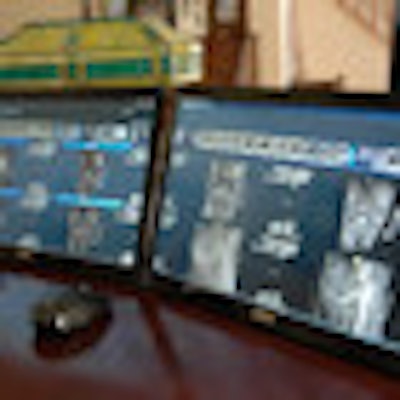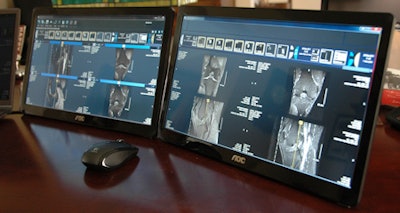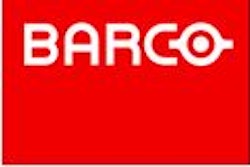
While laptops have the computing power to support image viewing, their small displays can limit their utility. However, two portable and lightweight USB-powered monitors can be used to convert a laptop into a three-headed mobile workstation, according to radiologists from Kentucky.
In a study comparing two different portable USB-powered monitors for viewing cross-sectional images, image quality on both was judged to be as good as with standard 3-megapixel diagnostic displays, according to Dr. Eric Brandser from Radiology Associates of Northern Kentucky.
"Overall, the USB-powered lightweight monitors provide a portable method to view PACS-based imaging studies while on the go," Brandser said.
Brandser shared his experience with the USB-powered monitors during a scientific session at RSNA 2012.
PACS software is usually configured for radiologists to read on a three-headed workstation or a large-format two-headed workstation. Remote access allows radiologists to read studies from virtually anywhere, however, Brandser noted.
Laptops today have ample processor capacity and function very well, but they don't have a lot of screen real estate. Extra monitors, however, tend to be bulky and heavy, and they are cumbersome to configure because they typically use individualized, proprietary drivers, he said.
As an alternative, the Kentucky group sought to test two different USB-powered lightweight monitors from Toshiba (model PA3923U-2LC3) and AOC (E1649FWU) with a Samsung G7 series (NP700Z5AH) laptop to see if they could serve as a mobile, three-headed workstation for cross-sectional imaging studies. The Samsung laptop has two USB 3.0 ports and a 15.6-inch screen and uses the Windows 7 Home Premium operating system.
 |
| Lightweight USB-powered monitors can transform a laptop into a three-headed mobile workstation. Image courtesy of Dr. Eric Brandser. |
The Toshiba display offers a 14-inch diagonal screen and resolution of 1,366 x 768, and it's available for around $200, while the AOC display is a 16-inch monitor with a resolution of 1,366 x 768, available for around $100. Both displays employed the Laplink display adapter (Laplink Software) as their display driver.
Using version 6 of the Horizon Rad Station Distributed (McKesson) software, two radiologists independently reviewed CT and MR exams and compared the displays with a fixed hospital-based diagnostic workstation equipped with 3-megapixel monitors from Barco. The Toshiba and AOC displays were scored using a five-point scale (1 = identical performance, 2 = slightly degraded, 3 = moderately degraded, 4 = significantly degraded, and 5 = severely degraded).
The radiologists evaluated each system using both landscape and portrait mode. They also evaluated parameters such as monitor glare, brightness, viewing angle, aspect ratio, and weight and physical size of the monitors in storage configuration.
Due to its glossy screen, the AOC display had more glare (average score of 3.5) than the Toshiba display (average score of 2). Both displays rated highly on brightness, although the AOC display scored better (average score of 1) than the Toshiba unit.
On both systems, landscape mode (average score of 1.5) was better than portrait mode (average score of 4) for producing the best viewing angle. The AOC display was judged to be superior in portrait mode (3.5 versus 4), but both displays had similar scores in landscape mode.
The Toshiba unit's aspect ratio (average score of 1) was rated slightly higher than the AOC display's aspect ratio (average score of 2).
In other findings, the paired AOC monitors weighed 1,088 grams, while the Toshiba monitors weighed 755 grams. Using the OEM cases increased weight to 1,290 grams, according to the researchers.
Both models are lightweight and are easily set up for three-headed configurations, Brandser said.
"Instead of dragging around two or three laptops, this lets me look at PACS images in the format I'm accustomed to," Brandser said.
He noted that the displays also pair well with PACS software from Infinitt North America and GE Healthcare.




















